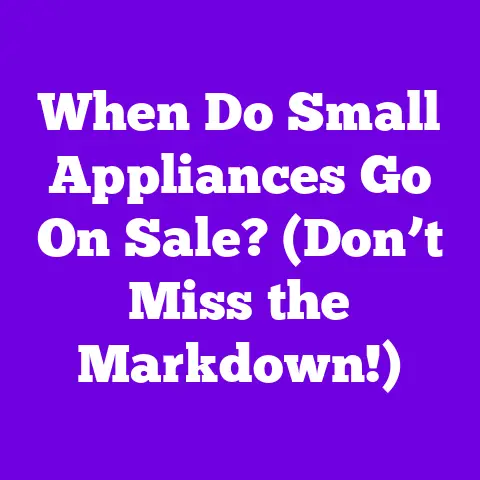When Do CPO Cars Go On Sale? (Don’t Miss These Steals!)
What does your perfect car taste like—smooth, powerful, or eco-friendly? Maybe you’re dreaming of a sleek sedan, a rugged SUV, or even a zippy electric vehicle. Whatever your automotive desires, finding the right car at the right price is key. That’s where Certified Pre-Owned (CPO) cars come in.
The market for CPO vehicles is booming, offering a sweet spot between the cost of new and the uncertainty of used. Knowing when CPO cars go on sale can unlock significant savings and help you snag your dream ride without breaking the bank. Let’s dive into the world of CPO cars and uncover the secrets to timing your purchase just right for 2025!
Understanding CPO Cars
What Exactly is a CPO Car?
Think of a CPO car as a used vehicle that’s gone through a rigorous makeover. To earn the “Certified” badge, a car typically needs to meet specific criteria. These often include:
- Age: Usually less than five or six years old.
- Mileage: Often capped at around 80,000 miles.
- Condition: Must pass a thorough inspection.
- Warranty: Comes with an extended warranty.
These standards are set by the manufacturer, ensuring a certain level of quality and reliability. For instance, Toyota’s CPO program requires a 160-point inspection, while BMW’s includes a detailed vehicle history report.
Why Buy CPO? The Perks
Why should you consider a CPO car over a brand-new or regular used one? Here’s a taste of the benefits:
CPO vs. Used: What’s the Real Difference?
The main difference boils down to assurance. A regular used car is sold “as is,” with no guarantees beyond its current condition. A CPO car, on the other hand, comes with a manufacturer-backed warranty and has been thoroughly vetted.
Here’s a quick comparison table:
| Feature | CPO Car | Used Car |
|---|---|---|
| Inspection | Multi-point, rigorous | Varies, often minimal |
| Warranty | Manufacturer-backed, extended | Limited or none |
| Reconditioning | Repaired to meet specific standards | May or may not be reconditioned |
| Price | Higher than used, lower than new | Lowest price |
While a used car might be cheaper upfront, the potential for unexpected repairs can quickly erase those savings. CPO cars offer a safer bet, especially for first-time car buyers or those on a tight budget.
The CPO Market Landscape for 2025
Automotive Trends Shaping CPO Sales
The automotive industry is constantly evolving, and these trends will impact the CPO market in 2025:
- Electric Vehicle (EV) Adoption: As EVs become more popular, expect to see more of them entering the CPO market. This could be a great opportunity to snag a used EV at a lower price.
- Supply Chain Issues: Lingering supply chain disruptions could continue to affect new car production, driving more buyers to the CPO market.
- Economic Factors: Economic uncertainty could lead more consumers to opt for CPO cars as a more budget-friendly alternative to new vehicles.
- Rising Interest Rates: Higher interest rates for new car loans might push more people towards CPO options with potentially better financing deals.
I’ve noticed a surge in interest in used EVs lately. People are curious about electric cars but hesitant to pay the premium for a new one. CPO EVs offer a perfect entry point.
Projecting CPO Inventory Levels
Predicting inventory levels is tricky, but here’s what experts are saying:
- Increased Availability: As new car production catches up, more trade-ins will flood the CPO market, increasing inventory.
- Higher Demand: Demand for CPO cars is expected to remain strong, driven by affordability and the desire for reliable transportation.
- EV CPO Growth: The number of CPO EVs is projected to increase significantly as early adopters trade in their older models.
According to a report by Cox Automotive, the CPO market is expected to see a modest increase in sales in 2025, driven by increased supply and continued consumer demand.
When Do CPO Cars Go On Sale?
Decoding Seasonal Sales Patterns
Just like clothing and holiday decorations, CPO cars have their own seasonal sales patterns. Here’s what to look out for:
- End of the Year (October – December): Dealerships are eager to clear out their inventory to make room for new models. This is often the best time to find deep discounts and special financing offers.
- Holiday Sales (Memorial Day, Labor Day, Black Friday): Major holidays often bring promotional events and incentives to attract buyers.
- End of the Month: Salespeople are often trying to meet monthly quotas, so you might be able to negotiate a better deal towards the end of the month.
I’ve personally found that December is a fantastic time to buy. Dealerships are motivated to hit their year-end targets, and you can often score a great deal.
A Monthly Breakdown for CPO Deals
Let’s break down the year month by month to give you a clearer picture of when to strike:
- January: Things are usually slower after the holiday rush, but you might find some leftover deals.
- February – March: Sales tend to pick up as tax refund season approaches.
- April – May: Dealerships often launch spring sales events.
- June – August: Summer is a popular time for car buying, but deals might be harder to come by.
- September: New models start arriving, so dealerships might offer discounts on older inventory.
- October – December: The sweet spot for finding the best deals as dealerships clear out their lots for the new year.
Keep an eye on specific manufacturer promotions. For example, some brands offer special financing rates or extended warranties during certain months.
The Power of Manufacturer Incentives
Manufacturer incentives can significantly impact CPO sales. These incentives might include:
- Low-Interest Financing: Offering attractive interest rates can make a CPO car more affordable.
- Extended Warranties: Adding extra warranty coverage can provide peace of mind and attract buyers.
- Cash-Back Offers: Providing cash rebates can sweeten the deal and lower the overall price.
These incentives are often tied to specific sales periods or models, so it’s essential to stay informed. Check manufacturer websites and local dealership advertisements to see what’s available.
Tips for Finding the Best CPO Deals
Do Your Homework: Research and Preparation
Before you even step onto a dealership lot, do your research. This includes:
- Identifying Your Needs: What kind of car do you need? What features are essential?
- Researching Models: Read reviews, compare specifications, and check reliability ratings.
- Understanding Pricing: Use online tools like Kelley Blue Book (KBB) and Edmunds to get an idea of fair market value.
- Checking Vehicle History: Obtain a vehicle history report from Carfax or AutoCheck to uncover any potential issues.
I always tell people to start their research online. Knowing what you want and what it’s worth will give you a significant advantage when negotiating.
Negotiation Tactics That Work
Negotiation is a key part of getting a good deal on a CPO car. Here are some tactics to try:
- Be Prepared to Walk Away: The ability to walk away gives you leverage.
- Focus on the Out-the-Door Price: This is the total price, including all fees and taxes.
- Negotiate Separately: Negotiate the price of the car before discussing financing or trade-ins.
- Point Out Flaws: If you spot any minor imperfections, use them as bargaining chips.
Remember, the goal is to reach a price that you’re comfortable with. Don’t be afraid to haggle and be persistent.
Timing is Everything: When to Act
As we’ve discussed, timing is crucial. Here’s a recap of when to act for the best deals:
- End of the Year: Aim for October through December for the biggest discounts.
- Holiday Sales: Keep an eye out for special promotions during major holidays.
- End of the Month: Visit dealerships towards the end of the month when salespeople are trying to meet quotas.
Be flexible and patient. The perfect deal might not appear overnight, but with persistence and the right timing, you’ll find it.
Where to Buy CPO Cars
Dealerships vs. Online Platforms
You have two main options for buying CPO cars: traditional dealerships and online platforms. Each has its pros and cons:
- Dealerships:
- Pros: In-person test drives, access to service departments, and the ability to negotiate face-to-face.
- Cons: Can be more expensive due to overhead costs, and the sales process can be stressful.
- Online Platforms:
- Pros: Convenient, transparent pricing, and a wide selection of vehicles.
- Cons: No in-person test drives, potential shipping costs, and less opportunity for negotiation.
I personally prefer dealerships because I like to kick the tires and take a test drive before making a decision. However, online platforms can be a great option if you know exactly what you want and value convenience.
Reputable Sources for CPO Cars
When shopping for CPO cars, stick to reputable sources. These include:
Final Thoughts on CPO Car Buying in 2025
Key Takeaways: Your CPO Cheat Sheet
Let’s recap the key points to help you navigate the CPO car market in 2025:
- CPO cars offer a sweet spot between new and used, with lower prices and added peace of mind.
- The CPO market is influenced by automotive trends like EV adoption and supply chain issues.
- Timing is crucial. Aim for the end of the year, holiday sales, and the end of the month for the best deals.
- Do your research, negotiate effectively, and choose a reputable source.
Take Action: Start Your CPO Journey Today!
The best time to start your CPO car search is now. Begin researching models, understanding pricing, and monitoring upcoming sales and trends. By staying informed and proactive, you can maximize your savings and satisfaction.
Conclusion
Remember that opening question about the taste of your perfect car? Finding the right CPO vehicle can satisfy not just your practical needs but also your personal preferences and lifestyle choices. With a little research, patience, and the right timing, you can drive away in a CPO car that tastes just right—smooth, powerful, eco-friendly, and affordable. Happy car hunting!






